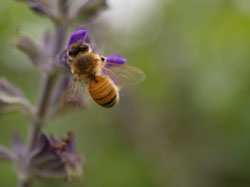Bumble bee disease studied
Bumble bees (Bombus spp) are very effective pollinators, both commercially and in natural ecosystems. Their feeding activities indirectly promote genetic variation and biodiversity. Moreover, insect pollination is essential for the production of seed from species that rely on outbreeding mechanisms. However, there is evidence that there is a consistent decline in numbers (with possible extinction) in some bumble bee species which is naturally of concern to conservationists and ecologists. Bumble bee rearing has developed into a commercial success due to the insect's efficacy in pollinating greenhouse crops. However, development of hundreds of thousands of colonies of bumble bees is bound to be accompanied with an ecological price. One of these is the parasitic disease Nosema bombi, a fungal disease that produces spores primarily in the excretory and nervous system of the bee. Apart from physiological effects including diarrhoea and a swollen abdomen, the queen is inhibited from mating and the viability of infected bees decreases. Colonies of bumble bees are bred worldwide and transported between countries and continents. To avoid introduction of non-endemic species of parasites, it is essential to investigate the genetic makeup of the invader. With commercial interests in mind, together with the future of the European bumble bee population generally, the European project POLLINATOR conducted a study of N. bombi. The team at Queen's University, Belfast specifically investigated the genome of the parasite for host-specific variation and possible genetic markers. The scientists created a genomic library to provide DNA regions that could be investigated for their suitability as genetic and phylogeographical markers. Illuminating results were produced when genetic sequences were isolated from only two spores of the fungus found within one bumble bee. Amplification, cloning and sequencing revealed that there were multiple ribosomal RNA copies that would give rise to different or non-homologous DNA sequences. The implications of this are that concerted evolution has not produced identical genetic sequences within one spore. Exotic parasite introductions have a habit of creating havoc within established ecosystems. Armed with results of this nature, we may be one step ahead of the genetic evolution of the fungus and more able to control the parasite within commercial populations of the bumble bee.







